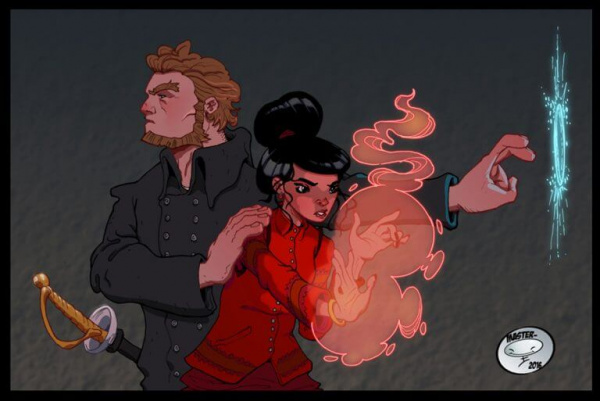Minor Key: Pevara Tazanovni
Author: Atarah al'Norahn
Published: January 6 2020 Tar Valon Times Blog Link
This article contains spoilers for the entire series.
“You’re so certain we will win?” Androl asked.
“Of course we will win. It’s not a question, Androl. We can’t afford to make it one.”
–Androl and Pevara, A Memory of Light, Chapter 4
Trapped in the Black Tower with enemies on all sides, Pevara staunchly refuses to yield. She insists not only on hope, but on resolve: Taim, his Dreadlords, and the Dark One must not be given the latitude of despair. In many ways, her tenacious pragmatism, here and throughout the series, finds its echo in Rand’s most important realization as the Last Battle approaches its climax—that the Shadow “cannot win unless we give up” (AMoL, Ch. 39). The determination and persistence in Pevara’s words to Androl are frequently indicative of her character.
Pevara Tazanovni is one of the few Aes Sedai characters whose past is not entirely shrouded in mystery. Born in Kandor more than one hundred and fifty years before the events of the first book, her early years in the White Tower were marked by terrible tragedy. While Pevara was a novice, her family was betrayed and massacred by friends who turned out to be Darkfriends; in Crossroads of Twilight, Pevara recalls learning the details of how her twelve year old brother had died “With a knife in his hand, standing over their father’s dead body and trying to keep the mob from their mother” (Ch. 23). It was this event that eventually lead Pevara to choose the Red Ajah, for she believed that “a Red hunting men who could channel had the best chance of finding Darkfriends” (ACoS, Ch. 32).
It is Pevara’s unrelenting hatred of Darkfriends that brings Seaine Herimon to her door for aid, even despite a long-estranged friendship. Believing that Elaida has set her the task of hunting the Black Ajah, Pevara is the only person Seaine implicitly trusts. Where so many sisters refuse to confess even the potential for Aes Sedai corruptibility, Pevara needs no convincing of the Black Ajah’s existence. She commits herself without hesitation to Seaine’s cause, as if it is a matter of course. For Pevara, it is; her nature is to continually forge ahead with what must be done, no matter the cost—even when frustration makes her want to “bite holes through bricks” (KoD, Prologue).
It is particularly indicative of Pevara’s character, however, that she pledges to assist Seaine even before learning why her erstwhile friend has come to her. Pevara insists from the start that “Short of a promise to stand in the Hall without knowing what for, whatever help I can give is yours” (ACoS, Ch. 32). Flouting not only the recent fragmentation of inter-Ajah relationships within the White Tower, but also her own Ajah’s longstanding precedent for discouraging relationships outside the Red, Pevara’s determination to resume her friendship with Seaine is worthy of note.
Pevara and Seaine’s relationship has several important juxtapositions within the series. The most obvious, perhaps, lies in the similarity their friendship as novices and Accepted holds to that of Siuan and Moiraine, rife as it was with pranks and exchanged confidences. But their relationship is also an interesting inverse, almost chiasmic in nature, of another famous Red/White pairing in the books: Elaida and Alviarin. Bitter at having been forced to name a White Keeper, and intent on charging Alviarin with treason, Elaida tasks another White with gathering evidence in absolute secrecy. Seaine, having misunderstood Elaida’s command as a mandate to hunt the Black Ajah, in turn approaches another Red for aid—not with fear or suspicion, but in remembered affection and trust.

“Androl and Pevara,” by AdamMasterman on DeviantArt.
By the final book of the series, Pevara finds herself fighting the Shadow in a different Tower, with a very different cohort. While trust might not be so easy here, it does come. It is a trust born not only of necessity, but also of growing empathy, fondness, and familiarity. Like virtually every other Aes Sedai charged with bonding Asha’man as Warders, Pevara’s initial goal in entering the Black Tower is to contain and control its inhabitants. What is significant about Pevara’s relationship with her Asha’man allies is the way in which it transforms over time: Pevara comes to see them not as tools to be used or as dangerous weapons to be blunted, but as partners to work alongside. With Androl in particular, this is perhaps aided by the nature of the double bond, which ensures that their relationship is not attended by the type of hierarchy that bonds often entail.
Ultimately, Pevara’s relationship with Androl is not only of critical use in the short term of the Last Battle; it also presents one of the most viable ways forward for the Red Ajah in the future. Her pointed comment after defeating two of Taim’s Asha’man—“What do you think the Red Ajah does with its time, Androl? Sit around and complain about men? We train to fight other channelers” (AMoL, Ch. 3)—is momentous because it is one of the only characterizations of the Red Ajah we see that is not centered on gentling men who can channel. It also poses the possibility that the Red Ajah might continue to protect the world against rogue channelers—male and female—in the coming Age. The tactical advantages offered by a collaboration between male and female channelers are immeasurable. Although it is perhaps in some ways untraditional and unconventional in terms of the Red Ajah’s former mandate, as Pevara herself says to Tarna: “I’ve been called worse than unconventional” (CoT, Ch. 22).